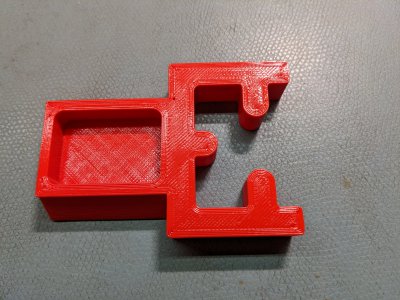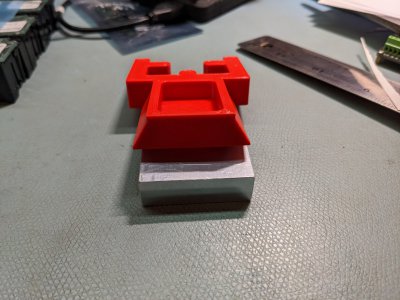- Joined
- Dec 18, 2019
- Messages
- 6,447
Coming back to this. I have been ignoring PETG, keeping it out of my mind. Until today. Now for the past month or so, I had the soggy red PETG in a vacuum bag with silica gel and partially evacuated. This apparently pulls absorbed moisture out of the PETG. Proof is in the pudding, as they say.
I did not change the base PETG settings in PrusaSlicer. I installed the "dried PETG" in my Prusa, sprayed my satin sheet with Aquamist unscented and cleaned the sheet. Aquamist apparently has dimethyl ether in it! Then dialed in the Z height and printed. No drama. Nothing bad happened. No crackling sounds in the extruder. As a matter of a fact, at the end, I just popped off the print. The vapors from the PETG are less than PLA, so that is good. I'm calling this a definite win.
This is an AXA lathe tool holder holder. It slides on 1.5" (38mm) 8020 (very snugly). The holders are held by the dovetail. There are minor issues with the print, but I am happy. PETG 0.3mm Draft, 20% grid infill. 4 line perimeters.


Same filament as before, just dried out under a partial vacuum. Well it's raining now, have to put the filament back in the bag... 30% RH in the house, 6% RH in the bag.
I did not change the base PETG settings in PrusaSlicer. I installed the "dried PETG" in my Prusa, sprayed my satin sheet with Aquamist unscented and cleaned the sheet. Aquamist apparently has dimethyl ether in it! Then dialed in the Z height and printed. No drama. Nothing bad happened. No crackling sounds in the extruder. As a matter of a fact, at the end, I just popped off the print. The vapors from the PETG are less than PLA, so that is good. I'm calling this a definite win.
This is an AXA lathe tool holder holder. It slides on 1.5" (38mm) 8020 (very snugly). The holders are held by the dovetail. There are minor issues with the print, but I am happy. PETG 0.3mm Draft, 20% grid infill. 4 line perimeters.


Same filament as before, just dried out under a partial vacuum. Well it's raining now, have to put the filament back in the bag... 30% RH in the house, 6% RH in the bag.

